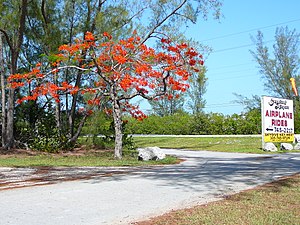| Revision as of 10:41, 7 September 2017 editNorthamerica1000 (talk | contribs)Autopatrolled, Administrators708,032 edits →top: + section header← Previous edit | Revision as of 10:42, 7 September 2017 edit undoNorthamerica1000 (talk | contribs)Autopatrolled, Administrators708,032 edits →Sugarloaf Key Bat Tower: Add image: <gallery caption="" widths="150px" heights="210px"> File:Sugarloaf Key FL Bat Tower04.jpg|The Sugarloaf Key Bat Tower </gallery>Next edit → | ||
| Line 12: | Line 12: | ||
| ==Sugarloaf Key Bat Tower== | ==Sugarloaf Key Bat Tower== | ||
| The ] was built in 1929 and is listed as a historic site.<ref name="Manaugh Twilley 2012">{{cite web | last=Manaugh | first=Geoff | last2=Twilley | first2=Nicola | title=The Bat Tower: The 30-Foot Monument to Biological Pest Control and Cross-Species Design | website=The Atlantic | date=November 20, 2012 | url=http://www.theatlantic.com/technology/archive/2012/11/the-bat-tower-the-30-foot-monument-to-biological-pest-control-and-cross-species-design/265465/ | access-date=September 7, 2017}}</ref> The tower was put there by a man named Perky to control the mosquito problem in the Lower Keys, but when the bats were put in, they flew away, never to return. Mr. Perky intended to found a city named after himself, but the city did not succeed due to the local mosquitoes. | The ] was built in 1929 and is listed as a historic site.<ref name="Manaugh Twilley 2012">{{cite web | last=Manaugh | first=Geoff | last2=Twilley | first2=Nicola | title=The Bat Tower: The 30-Foot Monument to Biological Pest Control and Cross-Species Design | website=The Atlantic | date=November 20, 2012 | url=http://www.theatlantic.com/technology/archive/2012/11/the-bat-tower-the-30-foot-monument-to-biological-pest-control-and-cross-species-design/265465/ | access-date=September 7, 2017}}</ref> The tower was put there by a man named Perky to control the mosquito problem in the Lower Keys, but when the bats were put in, they flew away, never to return. Mr. Perky intended to found a city named after himself, but the city did not succeed due to the local mosquitoes. | ||
| <gallery caption="" widths="150px" heights="210px"> | |||
| File:Sugarloaf Key FL Bat Tower04.jpg|The ] | |||
| </gallery> | |||
| ==References== | ==References== | ||
Revision as of 10:42, 7 September 2017


Lower Sugarloaf Key is the lower arm of an island known as Sugarloaf Key in the lower Florida Keys about 13 miles east of Key West.
U.S. 1 (or the Overseas Highway) crosses the key at approximately mile markers 16.5–17.5. Due to the routing of U.S. Route 1, it appears that Upper Sugarloaf Key and Lower Sugarloaf Key are separate islands, but they are actually one large "U"-shaped island.
As its name implies, Lower Sugarloaf Key is the lower arm of Sugarloaf Key, with the upper arm being Upper Sugarloaf Key. The island makes a loop on the Atlantic side with Upper Sugarloaf Sound and Park Key in the center. Although smaller in area, than Upper Sugarloaf Key, it is more densely populated and is also called Sugarloaf Shores.
It has Sugarloaf Lodge and restaurant, an airport and a volunteer fire department.
Sugarloaf Key Bat Tower
The Sugarloaf Key Bat Tower was built in 1929 and is listed as a historic site. The tower was put there by a man named Perky to control the mosquito problem in the Lower Keys, but when the bats were put in, they flew away, never to return. Mr. Perky intended to found a city named after himself, but the city did not succeed due to the local mosquitoes.
References
- Manaugh, Geoff; Twilley, Nicola (November 20, 2012). "The Bat Tower: The 30-Foot Monument to Biological Pest Control and Cross-Species Design". The Atlantic. Retrieved September 7, 2017.
24°38′38″N 81°33′47″W / 24.644°N 81.563°W / 24.644; -81.563
Categories: